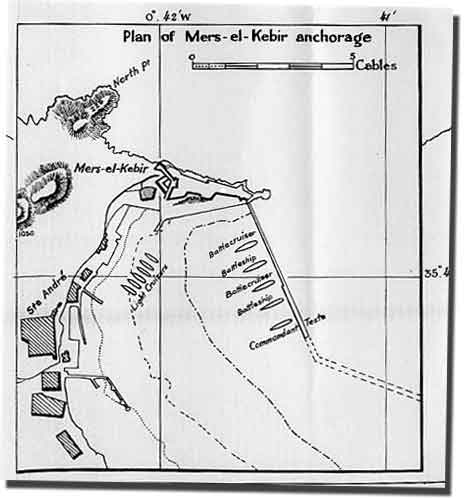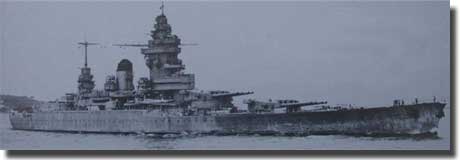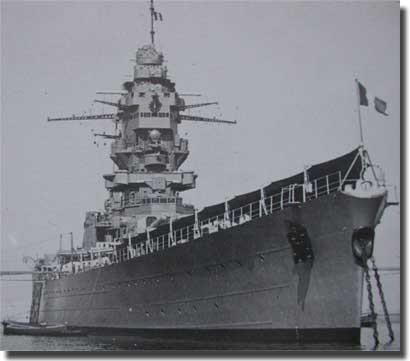Action against the French Fleet at Mers-el-Kebir by the British Force H over 3rd./6th. July 1940
Introduction.
The British Government were highly concerned that with the collapse of France what would happen to the French Fleet? On the 11th. of June 1940, Monsieur Reynard and his Government had gone to Tours, then on the 14th. had moved on to Bordeaux. It had been reported that Monsieur Reynard had declared
"We shall fight before Paris, we shall fight behind Paris, we shall shut ourselves in one of our provinces, and, if they drive us out, we shall go to North Africa, and, if need be, to our American possessions."
On the 16th. Monsieur Reynard had asked the British to release France from its Treaty obligations, but the Cabinet had refused this request. Over the night of the 16th./17th. he was no longer in power, being replaced by a deafeatist group headed by the old Marshal Petain, Admiral Darlan, Laval etc.
Negotiations with Germany for an armistice had started by the 17th. with France suing for peace to end the hostilities.
Every effort by Britain to persuade the French to send their Fleet to a British port, or sink their ships had been rejected. The armistice details were released on the 25th. of June, and the clauses governing the disposal of the French Fleet stated it would be assembled at ports under either German or Italian control and demilitarised. The British Government believed that neither Germany or Italy could be trusted in this regard to disarm the French ships, already they had evidence that Germany was using the French Naval codes.
British Government Decides.
Vice Admiral Sir James Somerville was sent off to Gibraltar to take command of Force H, it consisted of: The Battle Cruiser HMS Hood, ( flagship ) the Battleships, HMS Valiant, HMS Resolution, Cruisers HMS Arethusa and HMS Enterprise, Air Craft Carrier HMS Ark Royal, 4 Destroyers of the 8th. Destroyer Flotilla, Faulknor, Foxhound, Foresight, and Escort, 5 Destroyers of the 13th. Destroyer Flotilla, Keppel, Active, Wrestler, Vidette, and Vortigern.
At Mers-el-Kebir where the French Fleet was based were these ships: 2 Battle Cruisers, Dunkerque, and Strasbourg, 2 Battleships, Provence and Bretagne, 1 Aviation Transport, Commandant Teste, 6 Light Cruisers or Destroyers.

Plan of Mers-el-Kebir harbour
At Oran were an additional 7 Destroyers and 4 Submarines.
Shore batteries at Mers-el-Kebir were: 6 by 6 inch guns emplaced on the hill top to the west, 4 by 4.7 inch guns south of the harbour. In the vicinity of Oran, 3 by 6 inch guns at Point Canastel, 1 by 4 or 4.7 inch gun at Fort St Georgio, 1 or 2, 4 inch guns some 2,700 yards east of Oran Light.
When Flag Officer Force H arrived off Mers-el-Kebir he was to submit to the French Admiral in command 4 alternatives:
- Sail his ships to British ports and fight on with us.
- Sail his ships to a British port where the crews would be repatriated where they wished.
- Sail with reduced crews to a French port in the West Indies such as Martinique, where the ships would be demilitarised or entrusted to the United States until the war was over, and the crews repatriated.
- To sink their ships.
If the French Admiral refused to accept any of these proposals Sir James Somerville could accept demilitarisation of the French ships at their present berths, providing it could be achieved within 6 hours, and this action would prevent their use over the next 12 months.
If none of these alternatives were accptable to the
French, Somerville was ordered to destroy the ships, especially
Dunkerque and Strasbourg . The ships at Oran should also be destroyed if it did not entail any considerable loss of civilian lives.

French Strasbourg,
1940
Force H arrives off Mers-el-Kebir on the 3rd. of July 1940.
Captain Holland was given the task of negotiating with the French Admiral Gensoul, and he embarked in the destroyer Foxhound and proceeded to the harbour entrance. He was given approval for his ship to enter port at 0742 ( 7.42 AM ) on July 3rd, and Foxhound anchored 1.6 miles from the Mers-el-Kebir light at 0805 ( 8.05AM ) outside the boom net defence.
The French Flag Lieutenant came alongside and indicated that the French Admiral could not see Holland but would send his Chief of Staff. The British demands were handed over to the Flag Lieutenant and Holland waited for a response, at 1000 ( 10AM ) he returned with a written reply from his Admiral indicating:-
"His ships would never be surrendered, force would be met by force."
The French Chief of Staff now arrived at 1109 ( 11.09 AM ) but it was obvious that Holland was not going to meet Admiral Gensoul, to negotiate face to face.
Another message was sent via Lieutenant Commander Spearman who had accompanied Captain Holland in Foxhound, this one from Admiral Sommerville, stating that the French Ships would not be allowed out of the harbour unless they complied with the demands.
Back on Board Hood in Force H.
It was now 1227 ( 12.27 PM ) before Admiral Somerville received Admiral Gensoul's response. He now ordered mines to be laid inside the boom defences to guard against the French ships trying to break out of the harbour. Aircraft from Ark Royal now dropped 5 mines, and the French were given a deadline of 1500 ( 3 PM ) to comply with the British demands. At 1440 ( 2.40 PM ) Admiral Gensoul indicated he was prepared to receive a delegation for honourable discussions.
Captain Holland with Lieutenant Commander Davies now took off for the Dunkerque in Foxhound's motor boat, arriving there at 1615 ( 4.15 PM ) but Somerville thought that the French were merely stalling for more time.

Dunkerque,
1940
At Oran.
It was reported from Oran that ships were on the move in the harbour, and as a precaution to deter ships trying to break out, 2 mines were laid inside the harbour entrance/exit.
On board Dunkerque.
The French Admiral was coldly formal, he said
"The use of force by the British would only bring the whole French Navy against the British, and he would only obey the orders of his Government and Admiral Darlan"
The British Admiralty orders Somerville to get on with it!
Meantime, the British Admiralty ordered Somerville to settle the matter in hand quickly, and he signalled Admiral Gensoul both by wireless and visually
"To accept one of the 4 alternatives by 1715, ( 5.17 PM ) or at 1730 ( 5.30 PM ) your ships will be sunk."
Captain Holland and Davies made a hasty departure from Dunkerque at 1725 ( 5.25 PM ) just before the deadline expired.
Action by Force H at Mers-el-Kebir.
At 1754 ( 5.54 PM ) Force H opened fire on the French ships at a range of 17,500 yards. Desperate action for desperate times! The third salvoes fell amongst the ships, and the Battleship Bretagne blew up, a column of orange flame leapt into the sky followed by a huge column of smoke rising heavenwards for several hundred feet. A smaller explosion was a destroyer also being blown up.
The French shore batteries and the two Battlecruisers responded a minute after the first British salvo. After the British has fired 35 by 15 inch gun salvoes, return fire from the French reduced, but the Forts were increasingly accurate, and Force H made smoke to protect themselves.
End of Action.
At 1804 ( 6.04 PM ) cease fire was ordered. When the pall of smoke had cleared, Dunkerque who had slipped from the mole was stopped in the harbour, Provence appeared to be hit, of the Bretagne, not a sign anywhere. Clear of the harbour with 2 Destroyers the dunk was steering eastwards close under the land. 6 Swordfish aircraft escorted by Skua's were flown off Ark Royal to go after the fleeing French Battlership, which was duly attacked, one bomb hit was believed to have been achieved. This attack was to be followed up by 6 torpedo carrying aircraft, but darkness was approaching, and the chance of success was diminishing after the sun had set.
At Oran.
Meanwhile at Oran, Wrestler was forced to withdraw from her watching brief, as the shore batteries were getting very close with their fall of shot, some 100 shells all falling close by the Destroyer.
Chase Abandoned by Force H.
Although Vice Admiral Sir James Somerville with his force had set off in pursuit of the French Battleship Strasbourg with her 2 Destroyers, his old V and W WW1 Destroyers were struggling to keep up with the Fleet , the French had a good start and were fleet of foot, and some 25 miles ahead of his force. To catch the enemy seemed out of the question, and, at 2020 ( 8.20 PM ) he abandoned the chase.
His torpedo aircraft attacked Strasbourg at 2055 ( 8.55 PM ) one explosion was seen under her stern, but the sun had long set, and further attacks were discounted.
Message from French Admiral Gensoul.
Flag Officer Force H, at 2250 ( 10.50 PM ) received a message from Admiral Gensoul stating
"His ships were hors de combat, and personnel had been ordered to evacuate them."
It appeared to be all over, with the British mission to put the French Fleet in the main out of action, successful. A very distasteful job appeared to be at an end at last. The Fleet returned to Gibraltar at 1900 ( 7 PM ) on the 4th. of July 1940.
An
old newspaper article about HMAS Australia at Dakar
 |
Somerville reports to the Admiralty.
Somerville reported to his Admiralty that
Dunkerque was aground, but he was told
"Unless you are certain she cannot be in service for a year, this ship is to be subjected to further bombardment."
But by the 6th. of July, Their Lordships had changed their instructions, cancel any bombardment by ships, but air attacks were to be made until Dunkerque was thoroughly damaged. Three separate attacks were made on her by torpedo carrying Swordfish aircraft, and in all, 5 certain and 2 possible hits obtained.
Enough was enough! Finally Somerville was satified this French ship would no doubt be out of service for at least a year.
Conclusion.
This mission to put the French Fleet in the Mediterranean essentially out of the equation was over. It did have repercussions, General de Gaulle in September of that year mounted a very unsuccessful attack on Dakar in West Africa, and I was there in HMAS Australia, he was attempting to bring this area into the Free French Camp, but no doubt the bitter taste of the these events at Mers-el-Kebir was still very much around, and this venture was an abject failure. By 1830 ( 6.30 PM ) on the 6th. of July 1940 Flag Officer Force H and his ships were back at Gibraltar.




